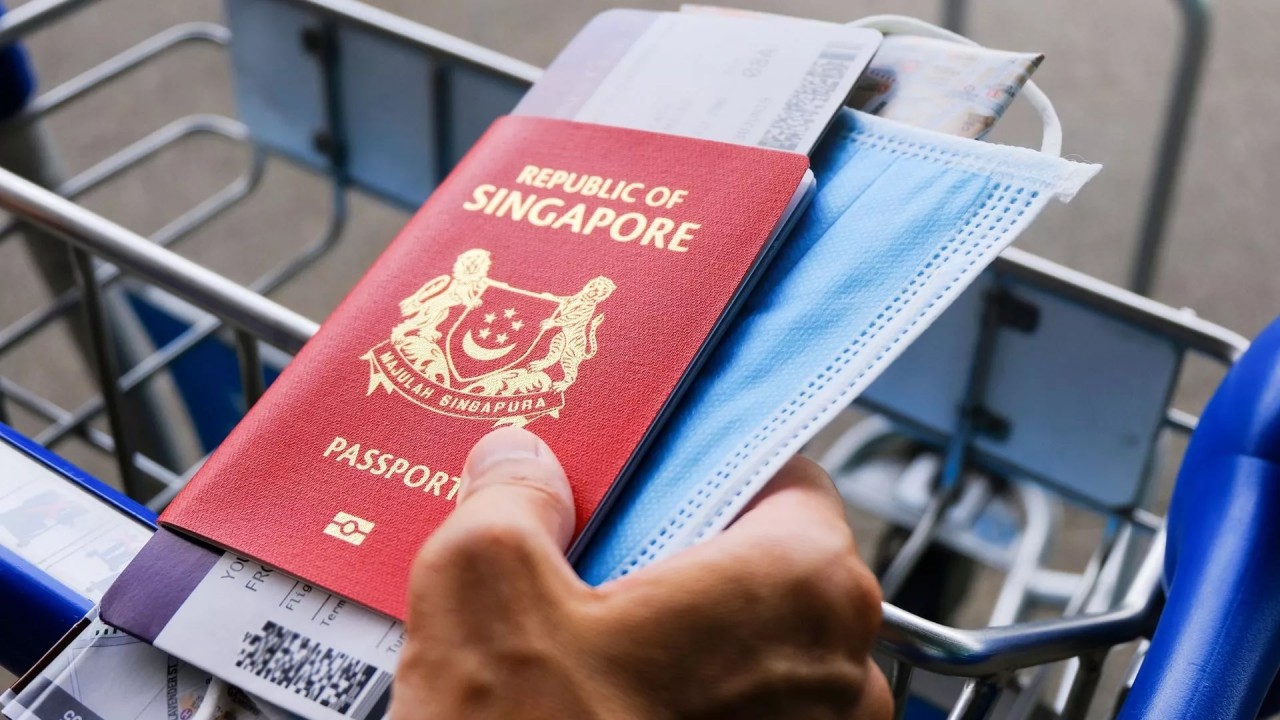The Best City Squares That You Can Visit In The World
Almost every city has some sort of square, serving an important purpose as a social and commercial meeting place. They are usually surrounded by shops, restaurants, and a city hall. At their center is often a fountain, monument, or a statue. But besides these similarities, town squares also have their own unique history.
A town square (or square, plaza, public square, city square, urban square, or piazza) is an open public space commonly found in the heart of a traditional town used for community gatherings. Related concepts are the civic center, the market square and the village green.
Most squares are hardscapes suitable for open markets, concerts, political rallies, and other events that require firm ground. Being centrally located, town squares are usually surrounded by small shops such as bakeries, meat markets, cheese stores, and clothing stores. At their center is often a well, monument, statue or other feature. Those with fountains are sometimes called fountain squares.
1. Plaza Mayor
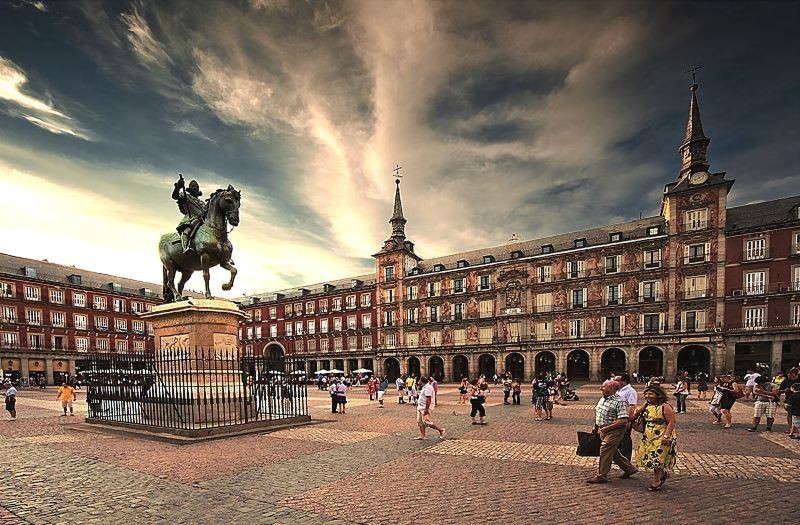 |
| Photo: Trip.com |
The Plaza Mayor (English: Town square) is a major public space in the heart of Madrid, the capital of Spain. It was once the centre of Old Madrid. It was first built (1580–1619) during the reign of Philip III. Only a few blocks away is another famous plaza, the Puerta del Sol. The Plaza Mayor is a space for the people of Madrid and tourists to shop, walk around, eat, and enjoy the outdoors.
There is a bronze statue of King Philip III at the center of the square, created in 1616 by Jean Boulogne and Pietro Tacca. Giambologna's equestrian statue of Philip III dates to 1616, but it was not placed in the center of the square until 1848. The statue was a gift from the Duke of Florence at that time. It was Queen Isabel II ordered to move it from Casa de Campo to become the centerpiece of the Plaza Mayor.
The name of the plaza has changed over time. It has been known as "Plaza del Arrabal", "Plaza de la Constitución", "Plaza Real", "Plaza de la República" and now "Plaza Mayor". These names reflect events, history and reign in Spanish history.
"Plaza del Arrabal" was the original name of the present day "Plaza Mayor". The "Plaza del Arrabal" was once the site of the most popular marketplace until the end of 15th century. Following the Constitution of 1812, all major plazas in Spain were renamed "Plaza de la Constitución". It also held this name 1820 to 1823, 1833 to 1835, 1840 to 1843, and 1876 to 1922. When the Borbón king was restored in 1814, it became known as the "Plaza Real". In 1873, the name changed to "Plaza de la República". At the end of the Spanish Civil War the plaza received its present name of "Plaza Mayor".
2. Trafalgar Square
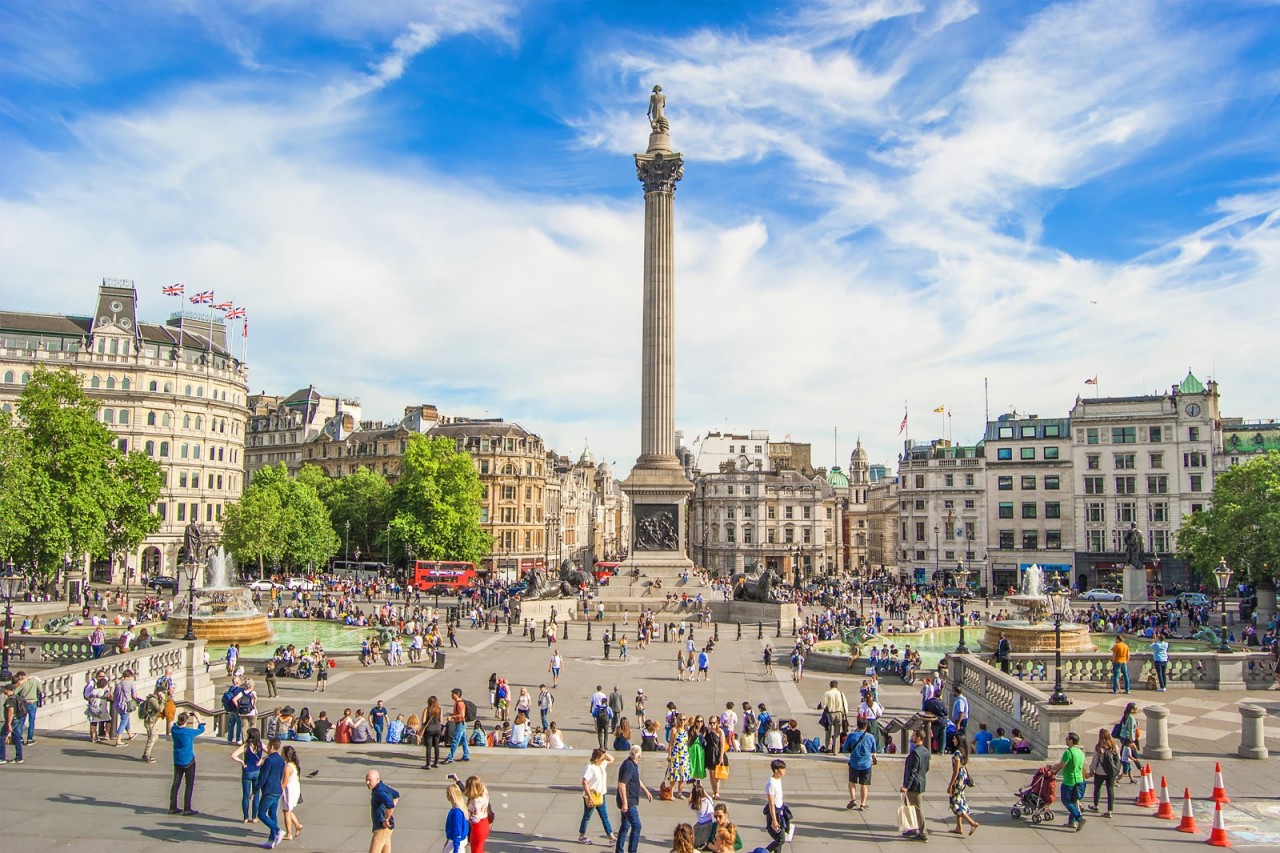 |
| Photo: Hotels |
Trafalgar Square is a public square in the City of Westminster, Central London, established in the early 19th century around the area formerly known as Charing Cross. The Square's name commemorates the Battle of Trafalgar, the British naval victory in the Napoleonic Wars over France and Spain that took place on 21 October 1805 off the coast of Cape Trafalgar.
The site around Trafalgar Square had been a significant landmark since the 1200s. For centuries, distances measured from Charing Cross have served as location markers. The site of the present square formerly contained the elaborately designed, enclosed courtyard, King's Mews. After George IV moved the mews to Buckingham Palace, the area was redeveloped by John Nash, but progress was slow after his death, and the square did not open until 1844. The 169-foot (52 m) Nelson's Column at its centre is guarded by four lion statues. A number of commemorative statues and sculptures occupy the square, but the Fourth Plinth, left empty since 1840, has been host to contemporary art since 1999. Prominent buildings facing the square include the National Gallery, St Martin-in-the-Fields, Canada House, and South Africa House.
The square has been used for community gatherings and political demonstrations, including Bloody Sunday in 1887, the culmination of the first Aldermaston March, anti-war protests, and campaigns against climate change. A Christmas tree has been donated to the square by Norway since 1947 and is erected for twelve days before and after Christmas Day. The square is a centre of annual celebrations on New Year's Eve. It was well known for its feral pigeons until their removal in the early 21st century.
3. Plaza de Armas
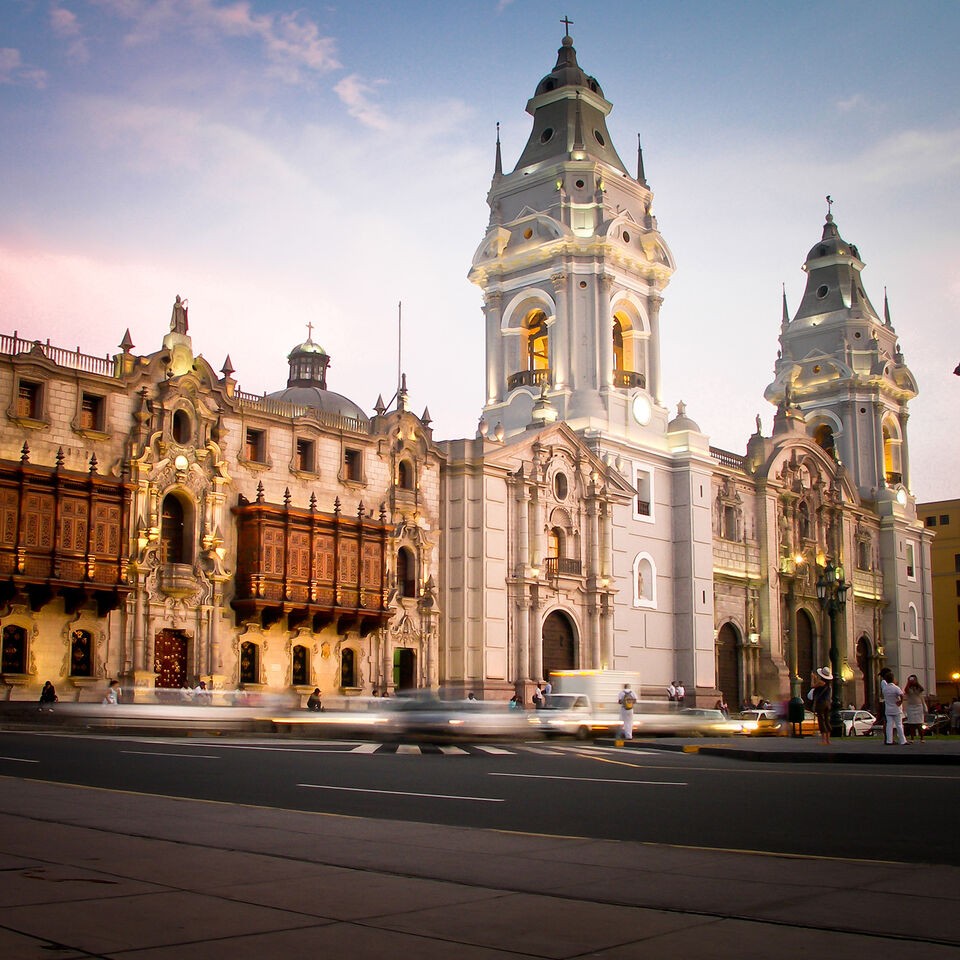 |
| Photo: KLM Travel Guide |
Cusco’s main square – Plaza de Armas – is a busy and vibrant space that marks the colonial centre of the city. The plaza, which features wide stone pathways and well-kept colourful gardens, is home to two iconic buildings: the Cusco Cathedral and the Church La Compañía de Jesús.
Cusco’s Plaza de Armas covers part of the area that was once the Haukaypata – The Great Inca Square. Today however, Spanish colonial buildings and long stone arcades dominate the architecture of the plaza, but many of the precisely carved Inca walls remain as foundations.
The plaza is where many of the city’s most important gatherings, events and festivals take place, including Inti Raymi – the Inca Festival of the Sun and the religious festival of Corpus Christi.
The plaza is always bustling with activity whatever time of the day (or night), and is great place to soak up the laid back atmosphere of this Andean city.
Food & Drink in the Plaza
The plaza also has a wide variety of restaurants and eateries, which offer everything from traditional Peruvian food like cuy, lomo saltado and aji de gallina through to more well-known international cuisine like pasta, pizza and steak. Indeed the plaza is home to some of the city’s best restaurants like the up-market Limo or Gaston Acurio’s new gourmet burger restaurant Papachos.
4. The Grand Place
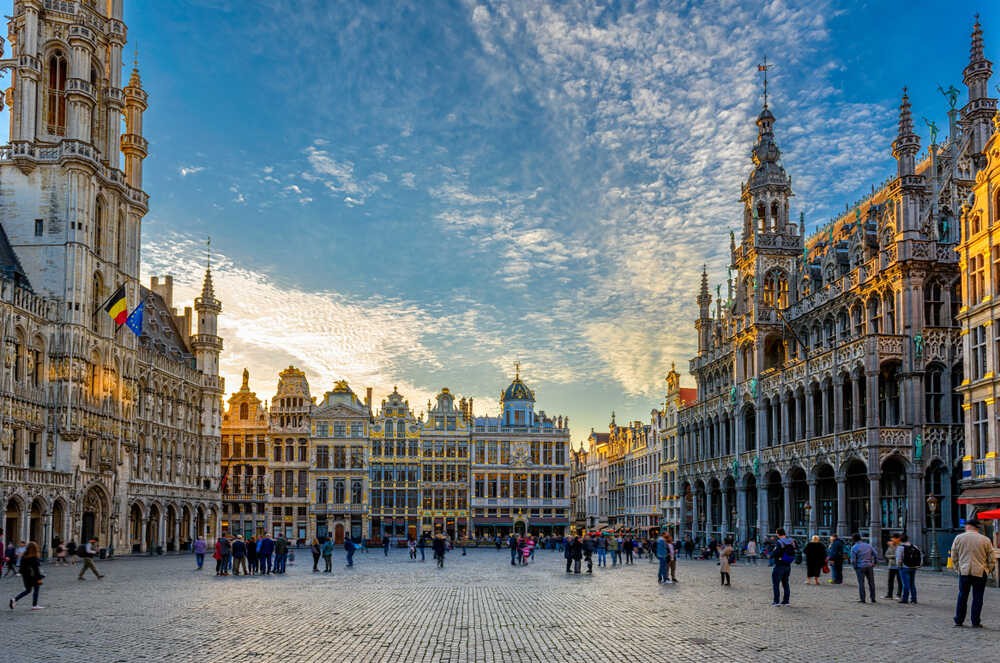 |
| Photo: Focus on Belgium |
The Grand Place is the central square of Brussels, Belgium. It is surrounded by opulent Baroque guildhalls of the former Guilds of Brussels and two larger edifices; the city's Flamboyant Town Hall, and the neo-Gothic King's House or Bread House building containing the Brussels City Museum. The square measures 68 by 110 metres (223 by 361 ft) and is entirely paved.
The Grand Place's construction began in the 11th century and was largely complete by the 17th. In 1695, during the Nine Years' War, most of the square was destroyed during the bombardment of Brussels by French troops. Only the facade and the tower of the Town Hall, which served as a target for the artillery, and some stone walls resisted the incendiary balls. The houses that surrounded the Grand Place were rebuilt during subsequent years, giving the square its current appearance, though they were frequently modified in the following centuries. From the mid-19th century, the square's heritage value was rediscovered, and it was thoroughly renovated.
Nowadays, the Grand Place is the most important tourist destination and most memorable landmark in Brussels. It is also considered one of the world's most beautiful squares, and has been a UNESCO World Heritage Site since 1998. The square frequently hosts festive and cultural events, among them, in August of every even year, the installation of an immense flower carpet in its centre. It is also a centre of annual celebrations during the Christmas and New Year period, and a Christmas tree has been erected annually on the square since the mid-20th century.
5. Piazza del Campo
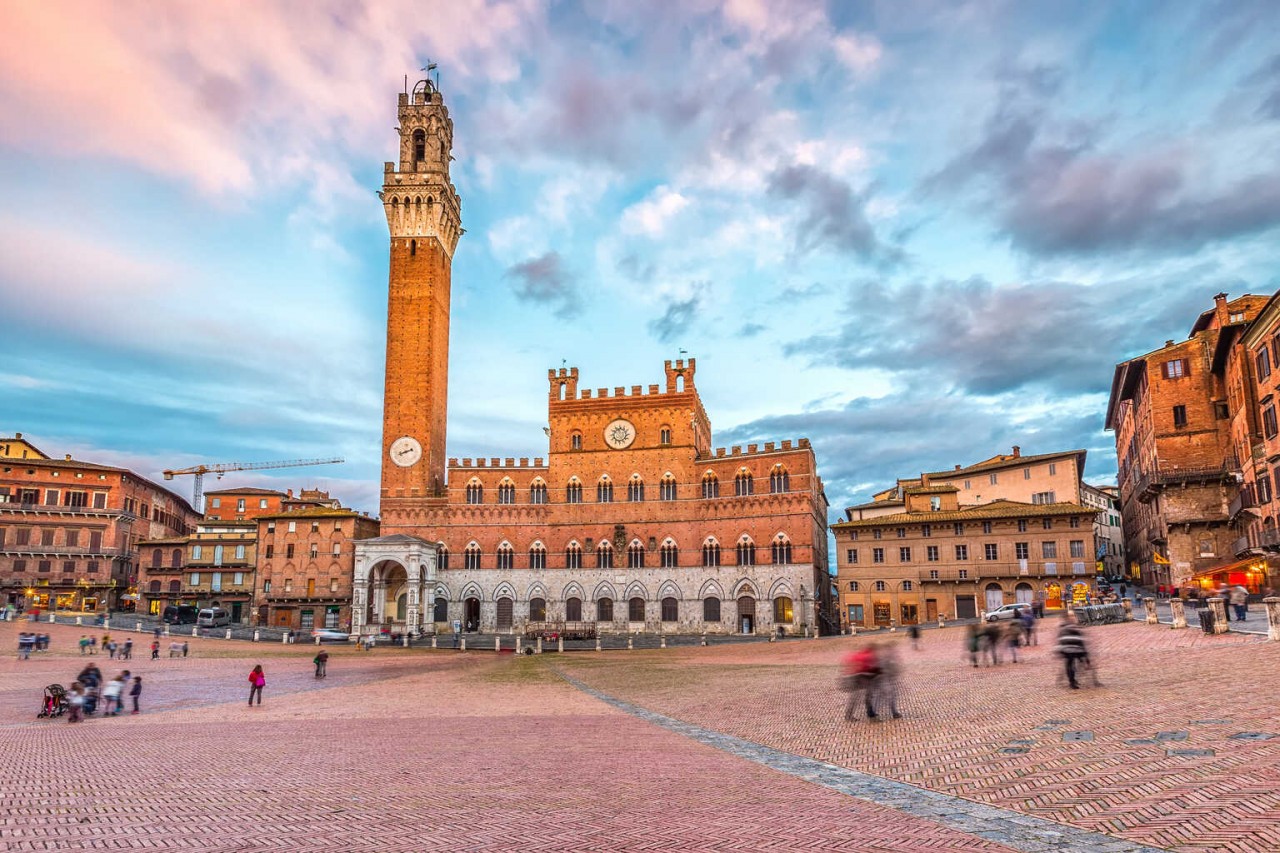 |
| Photo: Secret World |
Piazza del Campo is the main public space of the historic center of Siena, Tuscany, Italy and is regarded as one of Europe's greatest medieval squares. It is renowned worldwide for its beauty and architectural integrity. The Palazzo Pubblico and its Torre del Mangia, as well as various palazzi signorili surround the shell-shaped piazza. At the northwest edge is the Fonte Gaia.
The twice-a-year horse-race, Palio di Siena, is held around the edges of the piazza. The piazza is also the finish of the annual road cycling race Strade Bianche.
The open site was a marketplace established before the thirteenth century on a sloping site near the meeting point of the three hillside communities that coalesced to form Siena: the Castellare, the San Martino and the Camollia. Siena may have had earlier Etruscan settlements, but it was not a considerable Roman settlement, and the campo does not lie on the site of a Roman forum, as is sometimes suggested. It was paved in 1349 in fishbone-patterned red brick with 8 lines of travertine, which divide the piazza into 9 sections, radiating from the mouth of the gavinone (the central water drain) in front of the Palazzo Pubblico. The number of divisions is held to be symbolic of the rule of The Nine (Noveschi) who laid out the campo and governed Siena at the height of its mediaeval splendour between 1292-1355. The Campo was and remains the focal point of public life in the City. From the piazza, eleven narrow shaded streets radiate into the city.
The palazzi signorili[clarification needed] that line the square, housing the families of the Sansedoni, the Piccolomini and the Saracini etc., have unified rooflines, in contrast to earlier tower houses — emblems of communal strife — such as may still be seen not far from Siena at San Gimignano. In the statutes of Siena, civic and architectural decorum was ordered :"...it responds to the beauty of the city of Siena and to the satisfaction of almost all people of the same city that any edifices that are to be made anew anywhere along the public thoroughfares...proceed in line with the existent buildings and one building not stand out beyond another, but they shall be disposed and arranged equally so as to be of the greatest beauty for the city."
The unity of these Late Gothic houses is affected in part by the uniformity of the bricks of which their walls are built: brick-making was a monopoly of the commune, which saw to it that standards were maintained.
6. Main Market Square
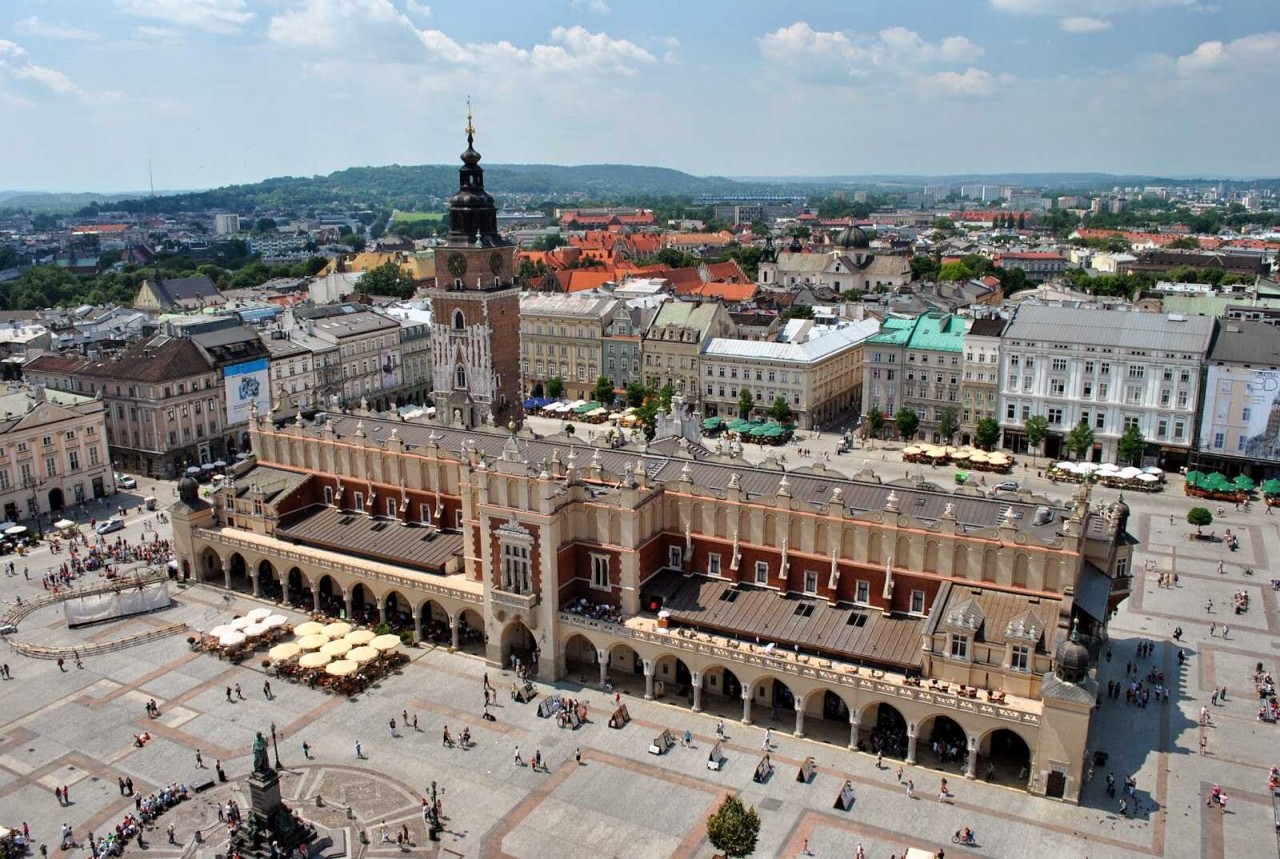 |
| Photo: Axel Bachmeier |
Kraków’s main market square ('Rynek Główny') serves as the city’s gravitational centre, and is the natural start and finish point for any tour of the city. Originally designed in 1257 - the year Kraków was awarded its charter – the grid-like layout of the Old Town and its central square has changed little in the years that have followed. Measuring 200 metres squared (40,000 square metres), the Rynek ranks as one of the largest medieval squares in Europe, and is surrounded by elegant townhouses, all with their own unique names, histories and curiosities. Through the centuries it was in Kraków’s Rynek that homage to the king was sworn and public executions held. Most famously it was here that Tadeusz Kościuszko roused the locals to revolt against foreign rule in 1794. The Rynek has always been the natural stage for public celebrations, with everything from parades of sausage dogs to Christmas crib competitions taking place. Not all the events have had been happy affairs however, and back in the 17th century King Jan Sobieski III was privy to a firework display which ended in bloodshed when some of the explosives were accidentally fired into the crowd. More recently the market square was subjected to a Nazi rally attended by Der Führer himself when the square’s name was changed to ‘Adolf Hitler Platz’ during German occupation. Fortunately the moniker didn’t last long and today the Rynek occupies itself by hosting annual Christmas and Easter markets, as well as numerous festivals and outdoor concerts.
7. Ba Dinh Square
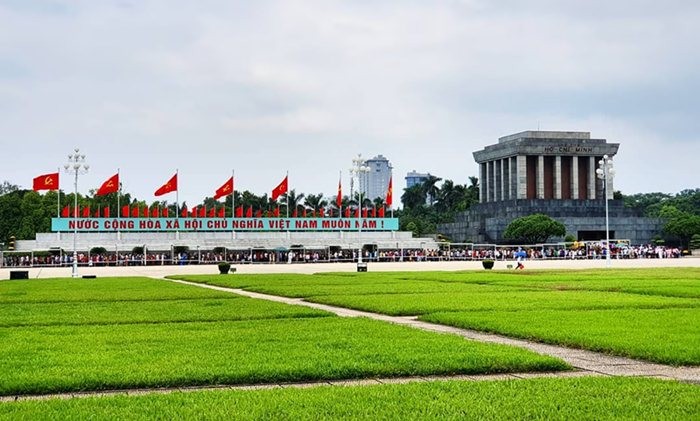 |
| Photo: Exotic Travel |
Ba Dinh Square is the largest square in Vietnam, located on Hung Vuong Street, Ba Dinh District. The square is the historical destination where the Ho Chi Minh Mausoleum was built. This square is also a place to recognize many important landmarks in Vietnamese history, especially on September 2nd, 1945, the President of the Provisional Revolutionary Government of Vietnam Democratic Republic Ho Chi Minh read the Declaration of Independence giving birth to the People’s Democratic Republic of Vietnam. Today it is known as the Socialist Republic of Vietnam.
Previously, this place was an area within the Imperial Citadel of Thang Long. In King Gia Long’s time, in 1808, the citadel was demolished to rebuild a much smaller city to serve as the capital of Bac Thanh. The area of Ba Dinh Square today corresponds to the West Gate of the new city at that time, was renamed Hanoi by King Minh Mang (son of King Gia Long) in 1831. The square used to be the place for the cultural activities of Northern people.
After conquering all of Indochina in 1894, the French army demolished the entire city, keeping only the North Gate as the evidence. This area was designed by French architects to build the administrative center of the Indochinese Federation. A small flower garden was built in the area, forming a large square named the Pugininer Garden (Le Parc Pugininer).
To take control of Indochina, on March 9th, 1945, Japan overthrew the French. Mayor Tran Van Lai decided to rename many places and streets in Hanoi with Vietnamese names, replacing the former French names. These new names were often in memorial of a national hero or a historical event. Hence, the rename of Ba Dinh Square was to honor the uprising against the French colonists of Dinh Cong Trang resistance army in Ba Dinh, Nga Son District, Thanh Hoa Province (1886-1887).
After the Declaration of Independence, Ba Dinh flower garden was renamed Ba Dinh Square. In 1954, a project of building a complex around Ba Dinh Square was proposed. The Complex included: Ba Dinh Hall (completed in 1963), Ho Chi Minh Mausoleum (1975), Ho Chi Minh Museum (1990), Monument to heroic martyrs (1994).
Today, Ba Dinh Square has a total area of 320m long and 100m wide, 210 squares of grass, intermingled with a 1.4m wide walkway. The center of the square is a flagpole of 25m high. This is the place where parades take place on the occasion of the great Vietnamese holidays, and also a place of sightseeing, fun, strolling tourists, and the people of Hanoi. In addition, Ba Dinh Square’s adjacent complex also contained several smaller projects like the One Pillar Pagoda and Uncle Ho’s stilt house area.
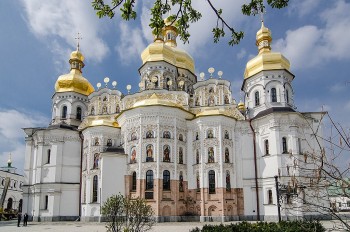 | Top 8 Most Impressive Ancient Tombs In The World Many ancient tombs were built many centuries ago with such impressive architecture and high aesthetics that some of them are considered the best tourist destinations ... |
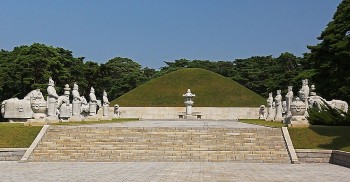 | Discover The Magnificent And Mysterious Koguryo Tombs Complex In North Korea The Koguryo Tomb Complex has over 10,000 tombs of kings, queens, and other royalty members, and was the first UNESCO World Heritage site in China ... |
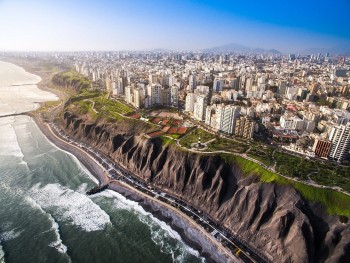 | Explore Amazing Lima: The City That Rains Every 600 Years The Peruvian city of Lima is the only city in the world that doesn't rain all year round, but this is still one of the ... |
Recommended
 Travel
Travel
Vietnam Through Australian Eyes: Land of Flavor, Warmth, and Timeless Charm
 Travel
Travel
Strategies for Sustainable Growth of Vietnam’s Tourism from International Markets
 Travel
Travel
Vietnam Strengthens Its Presence On The Global Tourism Map
 Multimedia
Multimedia
Phong Nha-Ke Bang National Park Named Top Adventure Travel Site
Popular article
 Travel
Travel
Vietnam Welcomes Record-High Number of International Visitors
 Travel
Travel
Luxury Train From Hanoi To Hai Phong To Be Launched In May
 Travel
Travel
Phong Nha Named Top Budget-Friendly Travel Destination for Spring 2025: Agoda
 Travel
Travel






